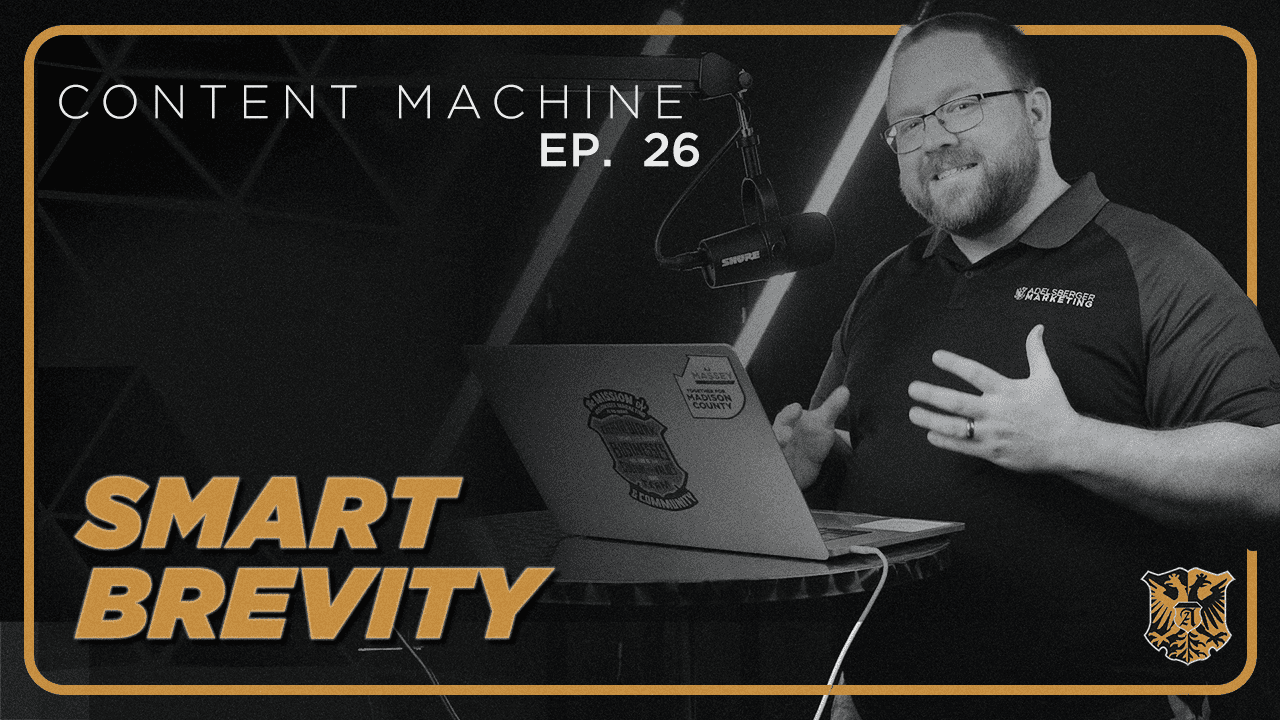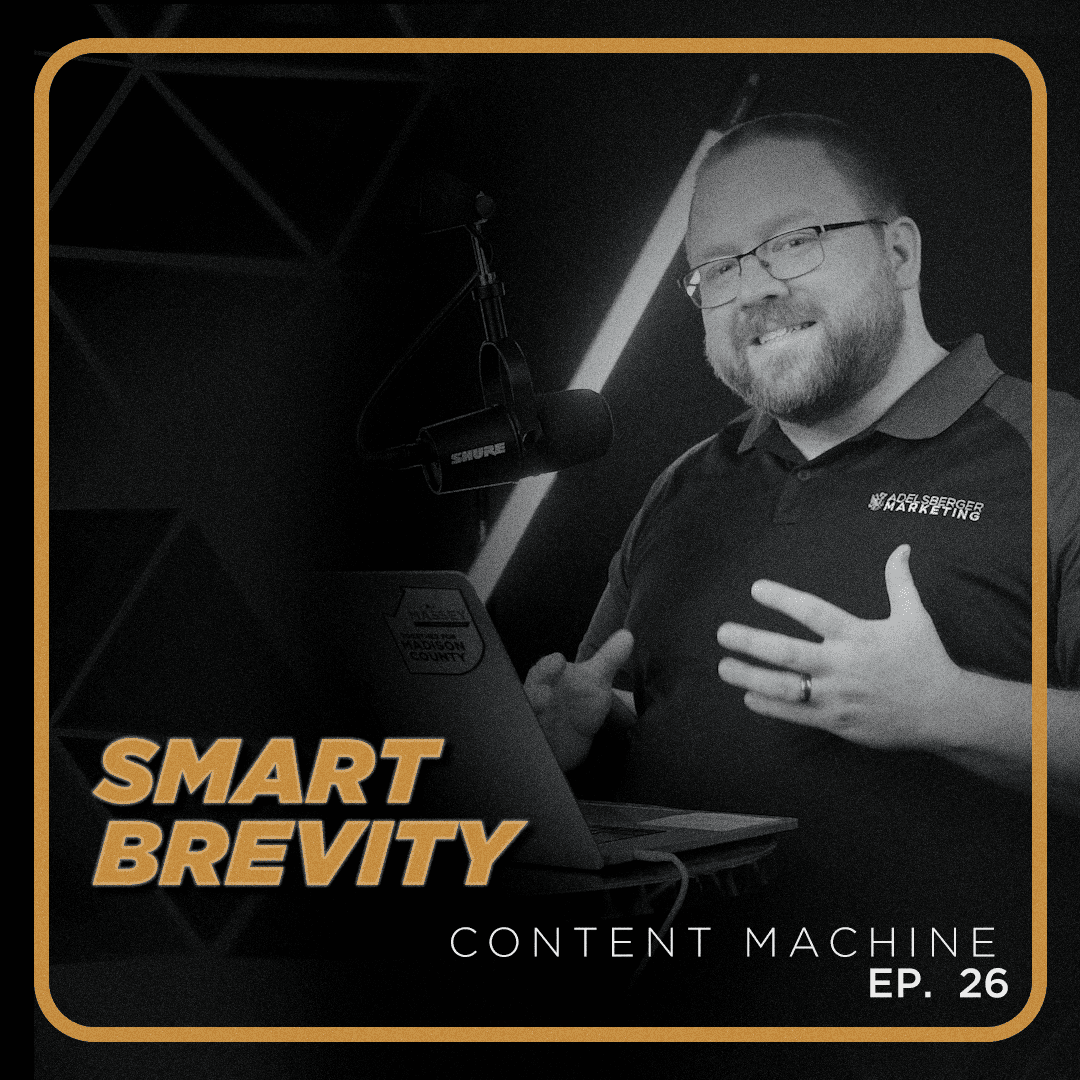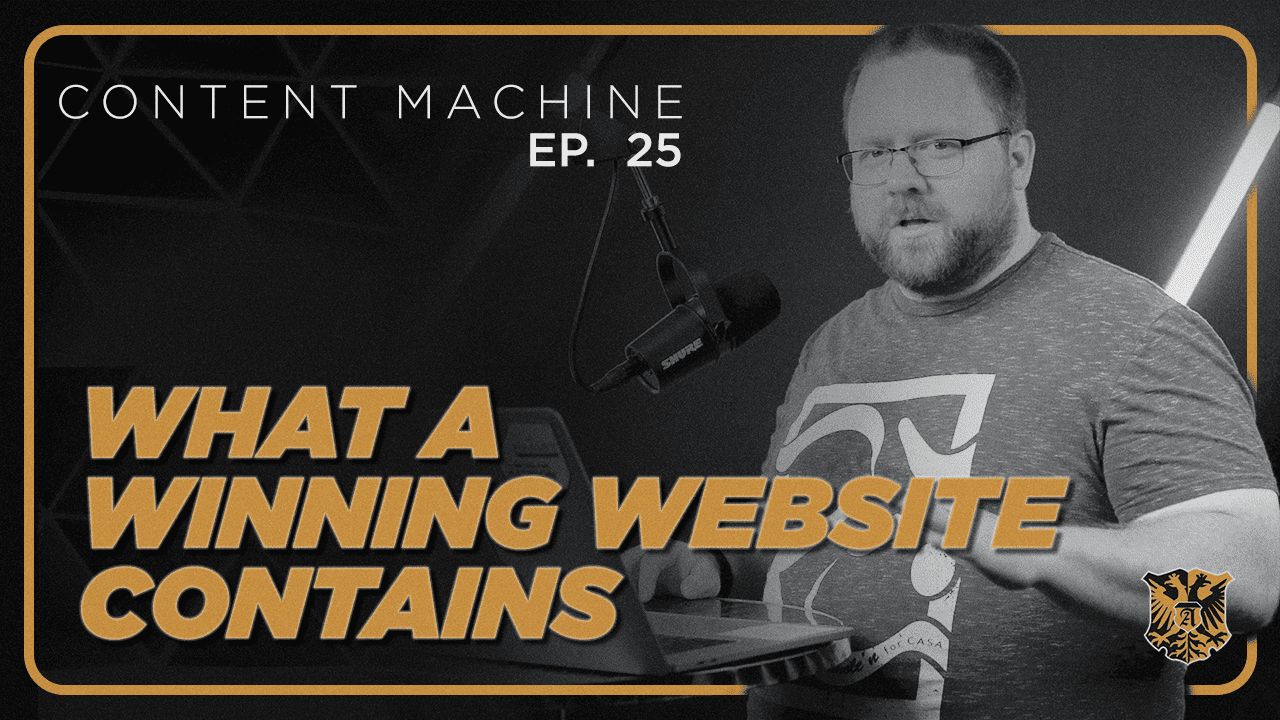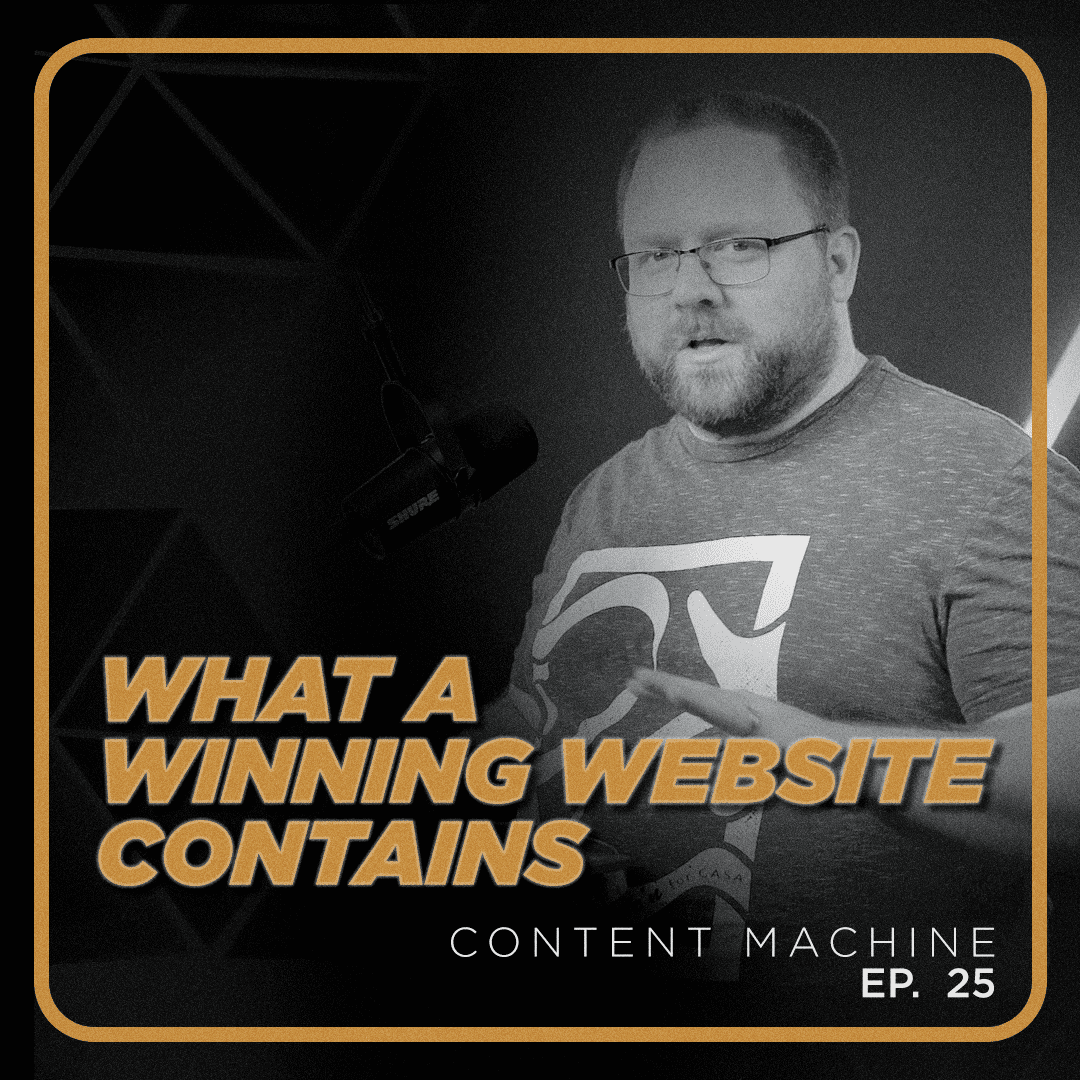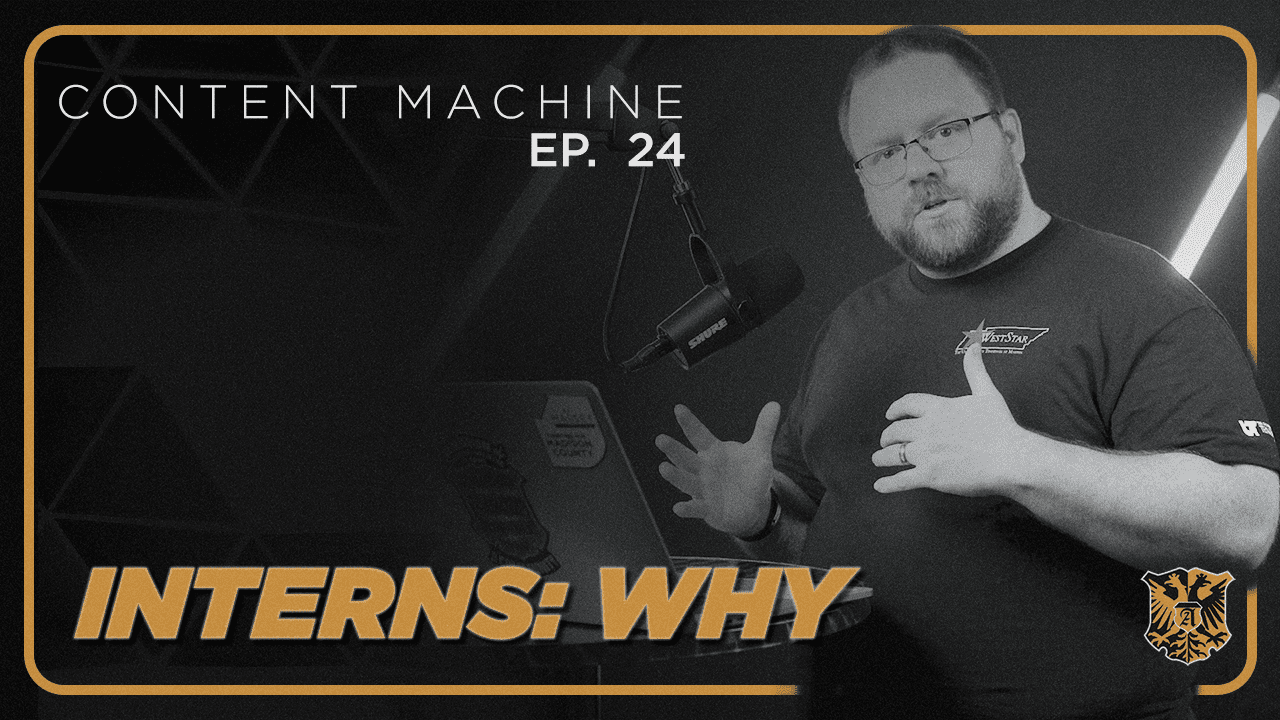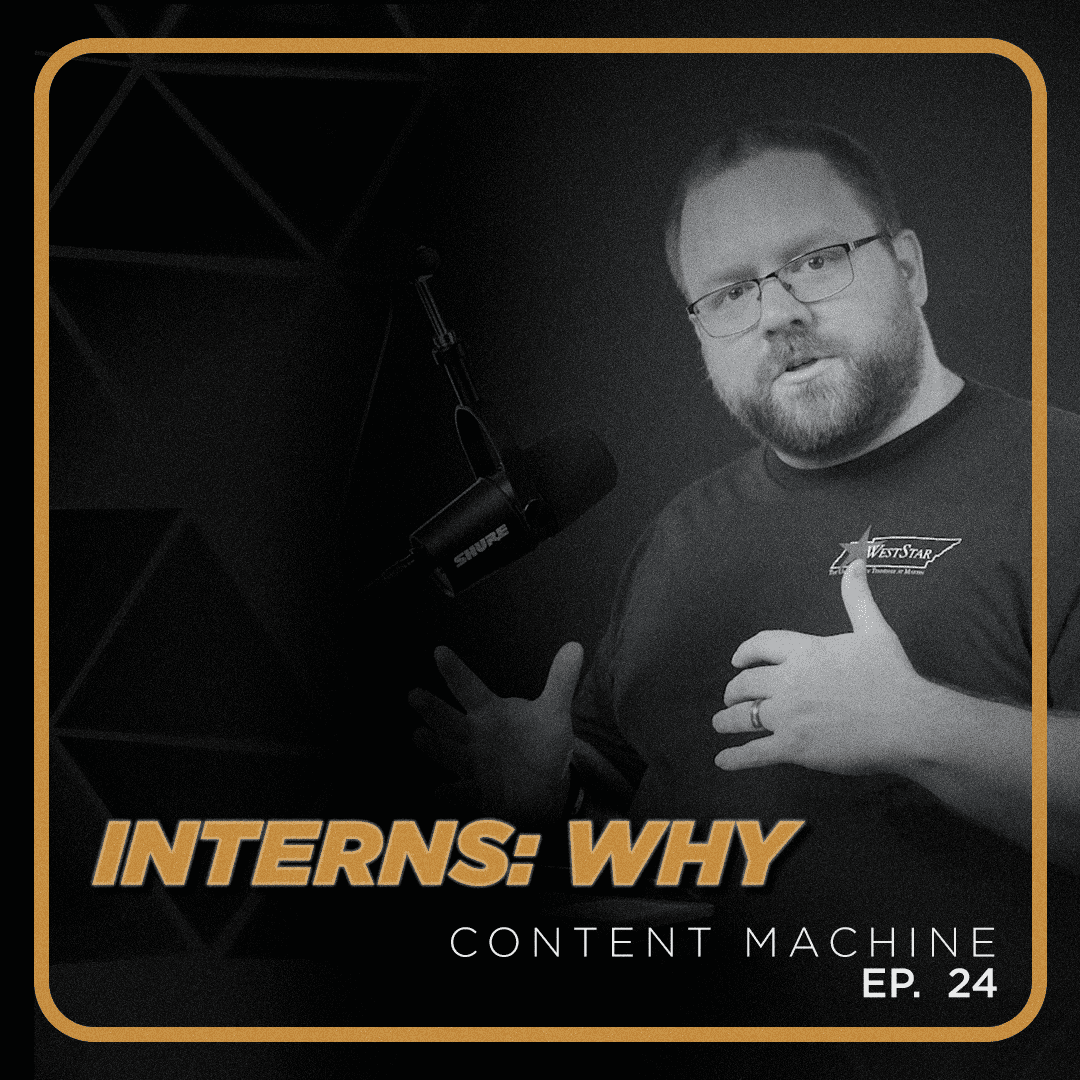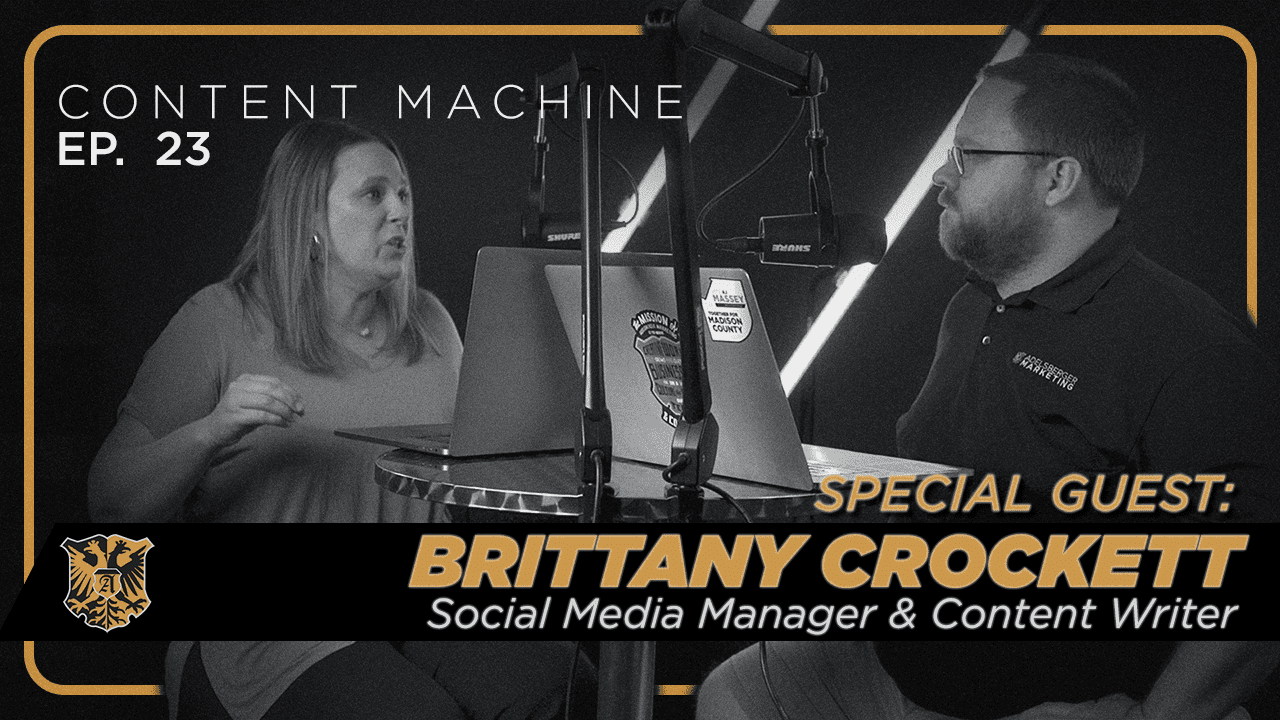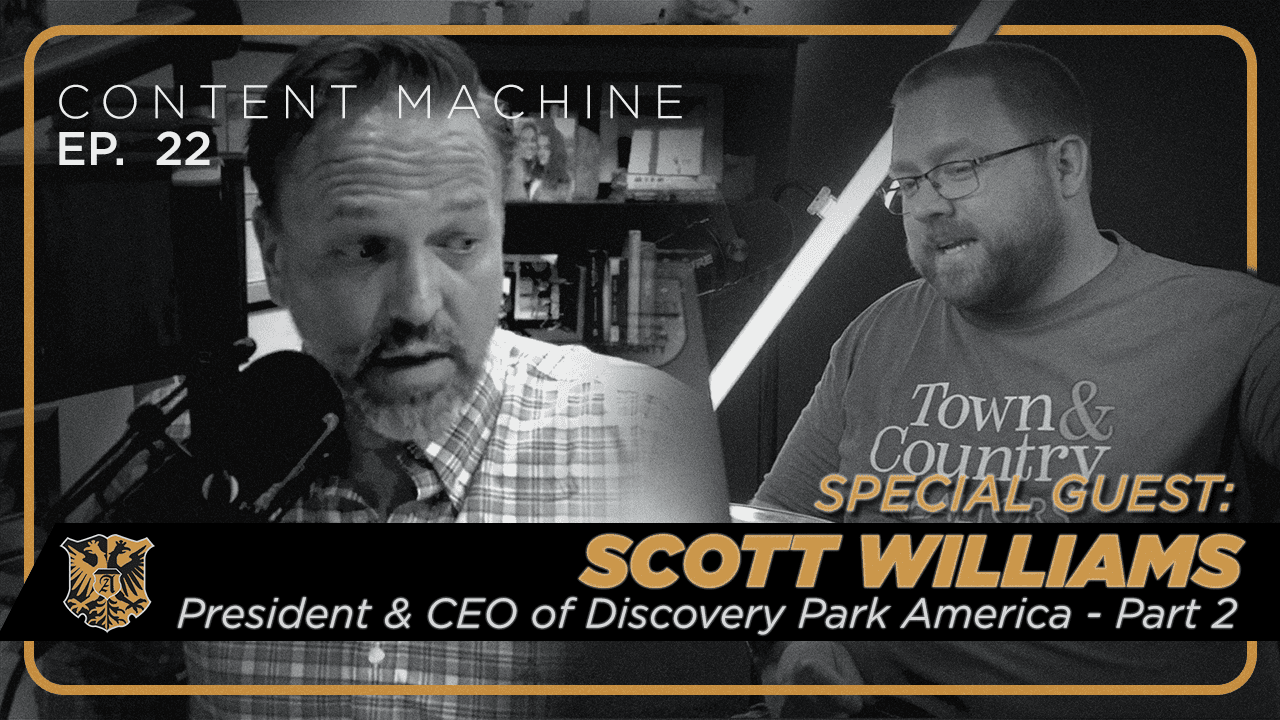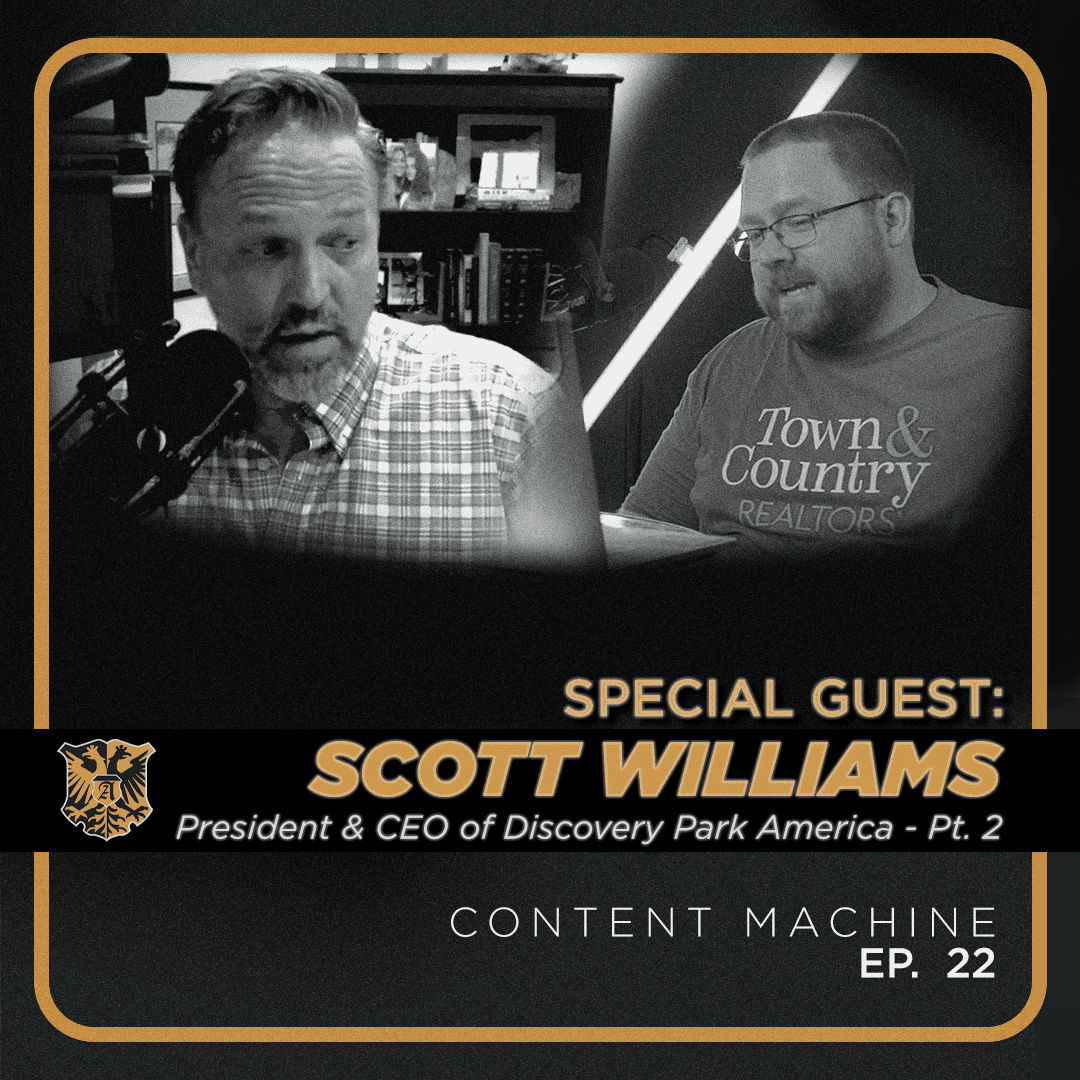Welcome to the Content Machine Podcast. We are listening to the second part of our interview with Scott Williams today. If you haven’t heard the first half, go back in your podcast feed and listen to the first half.
We do a lot of marketing here, and that’s the main focus of this channel. When you think about your general philosophy of marketing for a museum, which you’ve had the opportunity to be involved in at a couple of different locations now, what is that? You had students come and be like, “How do we sell a museum?” Where are you going to start?
Yeah, you know what? It’s really no different than selling anything else. You have to have everybody who’s working on the project and or the product know who is the target audience, number one. What is your objective? What strategies are you going to use? And then what tactics are you going to agree to use? And then how are you going to measure those so you can evaluate through time? You and I have both been associated with organizations or with individual campaigns where it’s just all over the place, where you start off, maybe everybody starts off, but so easy to veer off target and end up just checking off boxes and doing things, posting on Facebook because you’re supposed to. But are you measuring the effectiveness of that? Now more than ever, we can’t afford to have people just randomly out there flailing posting things. We got to be targeted on all the things that we do during the day. Is this contributing to the plan we’ve agreed on? Now, you got to be flexible and be willing to change the plan, but verbally change the plan or in writing change the plan. That’s probably the biggest challenge for me, especially. If you throw a stick, I am excited to go chase it for you. And I get that constantly. People will throw sticks and say, Oh, look, here’s another fun, shiny, pretty stick. And so I have to really watch myself and keep myself real then because I’m leading a whole team. So it’s easy for me to say, “Hey, everybody, let’s all go get the stick.” Now, a lot of my direct reports will tell you that I still struggle with that very mightily. So anyways, it’s pretty much just like the other aspect of this that’s probably different than other projects or other products is that we have to be very much aligned in tourism with our state tourism departments. If there’s a local convention and visitors bureau, it’s very smart to take advantage of every opportunity to partner with those folks who are also trying to do the same thing you’re trying to do, but oftentimes with bigger budgets. They’re trying to get visitors into the state or into the city. And so it’s really important to support them, buy the ads if they need you to do whatever you got to do to support them and help them be successful at what they’re doing because it’ll just pay off for you.
All right. So that’s like a 50,000 foot view. What do you specifically do to get people in the door at Discovery Park? What has worked for you guys?
I think the challenge of Discovery Park is the value proposition is a little different for everybody. So it’s making sure that people understand the value proposition. We had an incident Friday night where somebody was here. I happened to be here for an event that we were having here, but somebody just came into the front door and she said, “We’re staying at the hotel next door. What is this place?” And so I was able to explain it. She was from Chicago and her and her mom and dad were here for UT Martin’s graduation. And so I thought, Well, this is an interesting experience. I need to be able to do this exact thing on a broad scale every day. And so seeing who she was and I gage, where are you from? And found out who she was, where she was from, figured out about how old she was. And I was able to tell her about how much fun Discovery Park is and focus on some of the areas she was interested in history. I was able to say, here are some of the things that we have here. So we really have to be able to be very flexible in how we present Discovery Park because you are going to want to bring your kids here because you want to give them an incredible experience that will help further their education and help further their impression of the world. But if you and your wife were in your mid 60s and your kids have moved away, you want a different experience. You want to know that you can come here and it’s not a children’s museum. So we have to be very careful that we don’t over emphasize some of the things we have for younger people. We want you to be able to come here. And then by the time you get in your 80s, you might not want to have to walk around a lot. So you want to know that there’s enough in just the building that we wouldn’t focus on the 50 acres to you. We want to focus just on the building. With teachers, we promote the fact, well, first of all, there’s the Kirkland Scholarship Fund. So if you’re a teacher and you want to bring your class here, but you know you can’t afford it, your school can’t afford field trips, Discovery Park of America pays the tickets of schools who 50 % or more are on the free or reduced lunch program. So you would probably fall into that category if you were worried about expenses. And so we would promote that. First of all, it’s free. And second of all, it’s legitimately changing lives. And so we would make sure you understand that as a teacher who cares about these students, bringing them here could literally put them on a different course. And we have lots of research at this point that we share of students who have written us back and said, Hey, that discovery part changed my life, and here’s how. And so each of those different target audiences, we know what the value proposition is, what they’re looking for, what are the hot points, and we make sure we focus on that when we promote. One size does not fit all.
And then same thing with our development initiative. So we have to raise money. As a 501 nonprofit, we do make money off of ticket sales and restaurant sales and merchandise. But that only covers about half of our expenses. And so we have to fundraise. And so you, as a person who’s a philanthropist who’s looking for places where you might want to support, if you’re from California, you’re probably not super passionate about supporting West Tennessee, Kentucky. But there are a lot of philanthropists who are. And so we try to get in front of them and show them, look, we’re making a huge difference. If you join us and come alongside us, we can make an even bigger difference. So we have people who love to support educational facilities, and they come to us and say, here’s what I’m passionate about. Here’s what I want to try to do at your facility. And we work with them to develop a program where their funds can also be applied to do things like what we do here.
That multifaceted approach, is that a lot different than maybe the Museum or Graceland? Or is it the nature of the Discovery Park that it is so diverse that it’s a different animal?
It’s very similar to the Museum, but it’s very different than Graceland because Graceland was not a 501 nonprofit. So the difference between working for a nonprofit Museum and a for profit Museum is in a for profit Museum, if it doesn’t work on the Excel spreadsheet, you probably aren’t going to keep doing it. You need to make a profit. You need to pay for things and then make a profit. In the nonprofit world, things, of course, need to return on the investment, but oftentimes at a deficit. And that’s okay because people want to fund initiatives. And for example, our exhibit on innovation in agriculture, it would not be as fantastic as it is without the contribution of our partners like Simmons Bank, Nutri and Ag Solutions. There’s a lot of folks that contributed. Same thing with our Waterfall exhibit. We have many, many financial supporters who are, because they’re giving us the money, we’re able to do this incredible exhibit. We would do an exhibit, but it would not be as mind blowing as this one’s going to be. And so that’s a very different model between the two.
What are some of the challenges? I particularly think about the rural nature of Union City. How does that affect what the Discovery Park is doing?
Yeah. Obviously, a town of 10,000 is not going to support 100,000 square foot museum on a 50 acre heritage park. So it’s really crucial. A lot of museums will look at their community, their town. If we were in Chicago, we would be looking at Chicago as the community we serve. For us, the community we serve has to be has to be much, much broader. So we’re serving Nashville, Memphis, Jackson, Paducah, in some cases, St. Louis, and even Louisville. So our backyard is much bigger and much broader. So we have to really focus much differently on those areas. And then I would say probably our number one biggest challenge is we don’t have a gigantic employment pool to draw from in the first place. And then when you’re in an era like we’re in now, where everybody’s struggling to fill positions, we struggle even more. So filling positions, I think, is one of our big challenges now. We’re very fortunate that we have UT Martin. It’s 20 minutes away and we really position ourselves. And it is true that we are a place where people who are either students or just graduated can see what work is like. And so my direct reports and myself, we really try to make this be a place where young people can see what work is like, where we can model good leadership and we can model what they can expect. I give a little speech at every one of our orientations where I say, look, if you’re a young person and this is your first job, it is sometimes difficult to know what is normal because you don’t have a bar. And so we work really hard to set that bar high and teach young people this is what’s acceptable, this is what’s not acceptable. And we say if you don’t know, ask us. If you want to ask me or you want to ask our HR director, or you want to ask your manager, that made me feel uncomfortable. Is that normal? And also there are situations where I or one of the managers will ask somebody to do something and the person pushes back a little bit. They didn’t understand the difference between college and work. And they don’t understand the difference between us as professionals and hopefully mentors and professors. We’re not professors. We’re wanting engagement. We’re wanting them to give us their opinion. We’re wanting them to almost be peers and to approach it that way. So while it’s challenging trying to find positions, trying to find people to fill positions, it’s also created a great opportunity for us to really be almost like College 2.0 for a lot of people. And then also we have some incredible retirees who say, you know what? I have worked now. I just want a place to come every day and be fulfilled. We have a lot of retirees who come and work here and they love working with the young people. So it’s created an opportunity where there’s also a bit of a challenge.
How is more abundant web experiences like YouTube and VR going to affect museums in the future, you think?
So of course, I am curious with AI and how all that all of the technology. For us in the museum business, I think we’re going to look at how technology can help us solve problems, which is how can we better tell stories or communicate information? Just a few minutes ago before I got on this phone with you, I was looking at a technological experience that one of the museum companies is offering for rent or for sale. And while it looked compelling and it looked interesting, it’s only something that could be done one at a time. And so it was one piece of equipment and one individual could do it. But I thought that’s not going to solve any… That’s just going to create problems for us because the museum business is always feast or famine. You’ll have 600 people one day and 60 people the next day and 6 the next. So we have to be able to accommodate any of those. And I’m afraid too many people would be extremely disappointed if they came and stood in line and never got a chance to actually do the thing. And then they spent all their time here. So technology and both online and in person, it’s just another tool. There’s a tendency for me to want to be in every single thing all at once and to do everything and to be great at everything as an organization. But I do think we’re entering an era where I think I would rather be good, really great at less and so maybe not be everywhere. So I don’t know exactly yet which areas we might shave off, but in some cases, we’re just going through the motions. And that’s what I think we want to shave that off. And we want to be really excellent. We have a great opportunity because I’ve got a building full of people who are experts in a variety of sectors. And so whether it’s biology or history, I’ve got people that are passionate and they love to talk about those things. So I have content that no one else has. And so it’s how do we best use that, that then results in somebody buying a ticket to Discovery Park of America. At the end of the day, that is my objective is to get people through that turnstile. Now, if I inspire children and adults to see Beyond online and they never have to visit Discovery Park, that’s great. But I really need to get them through that turnstile.
Yeah, for sure. Well, speaking of content, the Real Footforward podcast is a podcast that you guys produce there at the Discovery Park. Can you talk about the what and the why behind that?
Yeah, sure. As we mentioned, Discovery Park is in a town of 10,000, and so our backyard was very small. We saw Real Footforward, a West Tennessee podcast, as an opportunity to broaden that to get people in Jackson, Memphis, not quite as far as Nashville, but we stay focused on West Tennessee. There are people out there that are doing incredible things that line up with our mission to inspire children and adults to see beyond. So it was an opportunity to get those individuals, spend a little bit of time, get to know them, have our listeners get to know them. And we’re getting in the neighborhood of 3,000 listeners to each podcast, which is solid for us. I’d love it if it was 30,000. But I’m happy with that. It also helps introduce us to people that don’t know about Discovery Park, and I still get that. People from Memphis or Nashville or Jackson, I still get now, Who are you? Now, what are you? Are you a water park? There are still people who don’t get what we’re about. But if I invite you to be on our podcast, which I did, you’re going to, first of all, even if it’s at the last minute, you’re going to Google it real quick and make sure you understand now who am I going to be with here? You’re going to make sure you know who we are. And then once you’ve been on the podcast and had a positive experience and you’ve listened to it, you made sure it sounds good, you’re going to then share it on social media. You’re going to let all your friends know about it. And then that way we can take advantage of your social network and just get it one more circle out in circulation. Now, the hardest thing, as you know, is to stay consistent. It is so easy to run out of guests and be too focused on other things to get some more in the can. We really have had to make sure it’s a priority. A while back, we said, Well, let’s just do it every other week. And we did that. And then we said, No, let’s just re commit. Let’s do it every week. And it’s given us a return on the investment of my time and of our financial resources to put it together. And once we get it down, it’s easy to produce and it’s fun to listen to. And I’ve had a lot of people who have said to me, I listen every week. I love the guests you have. Because sometimes I’m in the middle of one and I’m like thinking, Is anybody going to think this is interesting? I hope so. I will because I think everything’s interesting. And so I think, Oh, my gosh, I hope people are into this. And so far, they always seem to be. And we seem to have a good listenership. And we have a lot of people who email us and ask questions about the guest or whatever. So it’s become a little promotional tool that we started off not knowing if it was going to work or not. And so now, I think we’re like three years going strong.
It’s a Lot of time to produce podcast. Most don’t make it that far. Well, speaking of longevity, if you were to paint a picture of the future of the Discovery Park, what would you be looking at?
I think that it’s time for me to do a new three year strategic plan for Discovery Park. And so we’re looking at that. Obviously, with… Well, not obviously. If you haven’t been here, you wouldn’t realize that we have 50 acres. And so we have enough here for people to literally spend three days doing. So we don’t want to necessarily expand outwards and add a thousand different things. We want to vary with a lot of strategy, enhance and improve the experience and make it… We have traveling exhibits that come every year. And so we want to make sure the quality of those stays significant. During COVID, a lot of companies that developed traveling exhibits put everything on hold. So the American Association of Museums conference is coming up in a couple of weeks. And so we’re going to go to that and try to find some really fantastic bodies and Titanic level exhibits that we can bring in in 2025. So I think it’s just continuing what we’ve learned and building upon that, making sure that we’re here for the people of this region to bring their kids. And we have a joke the other day, we have had a lot of people who met here, and then they had their wedding here, and then they have their kids’ first birthday parties here. And so I joke that maybe we need to have a cemetery so that we could literally be creolous grave here at Discovery Park. So we want to continue this great relationship we have with the people of this region and continue to serve.
Well, Halloween would be a lot easier than two play off each other really nicely. Well, Scott, I want to say thank you for your time. Appreciate you coming on and appreciate what you’re doing at the Discovery Park. It should be an anchor of West Tennessee for years to come, and leadership is going to be required for it to do that. Appreciate what you’re doing up there. If you guys are interested in the Discovery Park, where should they go to find out more?
Discoveryparkofamerica.com. And then go buy a ticket.
Absolutely. And you know what? I’m up there all the time. I’d love to say hello. So ask for Scott Williams and I’ll give you the little welcome spiel.
All right. Well, thank you, Scott, and we’ll talk to you later.

